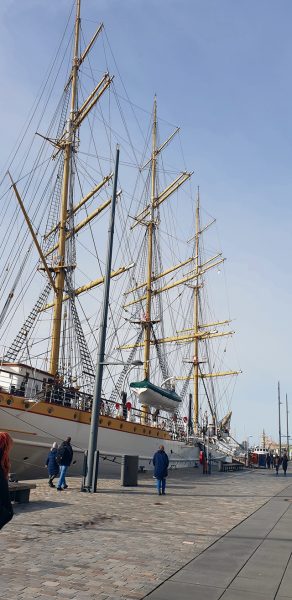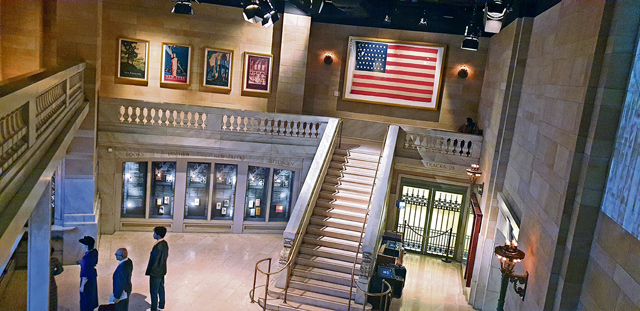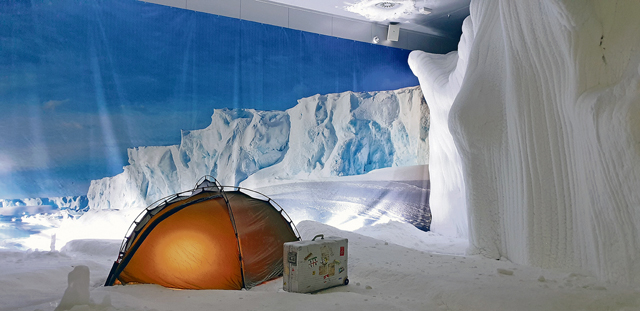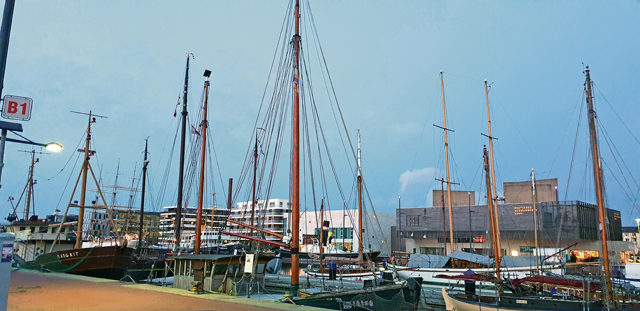
Anyone that has moved to Germany will sooner or later hit upon the term “Bremerhaven,” either in conjunction with a vehicle being shipped there or household goods arriving at the port. Some may have personally traveled to the city at the mouth of the Weser River to pick up or deliver a car. The U.S. Army also utilizes a separate section of the port to bring in equipment and heavy vehicles.
The joint port “Bremen-Bremerhaven” is Germany’s second largest port after Hamburg. One of the eight terminals is the Vehicle Terminal that handles up to two million vehicles a year, including many thousands of DOD members’ POVs arriving from or departing to the United States. In addition to cars and ships, Bremerhaven also has a world of wonders at its “Hafenwelten” (harbor worlds).
Emigration changed the world
Another very exciting terminal is the Columbus Cruise center, one of the most modern cruise ship terminals in the world. Ships from around the globe dock there to continue onto voyages in Scandinavia or across the Atlantic Ocean. The terminal also has a long tradition of being one of the busiest ports for emigration to the United States in the 19th and 20th centuries and is now an inspiring place to visit.
With a sharp increase of European emigrants seeking their fortunes in the New World in the mid 1850s, the port in Bremen became too small and Columbus Kai was opened in Bremerhaven in 1854. Millions of European emigrants left the port with hopes and dreams of a better life on the opposite side of the Atlantic Ocean and shaped the future of the United States.
Trace your roots at the Emigration Center
According to a 2020 census 191 million Americans, making up 57 percent of the population, have European roots. The largest group at 17 percent are said to be descendants of Germans, followed by Irish and Italians.
The “Deutsches Auswanderer-haus” (German Emigration Center) opened its doors in 2005 at the exact spot where emigrants began their voyage, the first center in Germany to focus on emigration. The center holds ship manifests of over 7.2 million passengers from 1830 to 1974 and is currently digitalizing the records for further reference. Their destinations were Buenos Aires, Argentina and Sydney, Australia, but over 75 percent emigrated to the United States.
Although not every German departed from Bremerhaven, approximately five million Germans alone set sail bound for the New World, among them over 500,000 from the Rheinland-Pfalz region. Other emigrants that embarked in Bremerhaven came from The Netherlands, Scandinavia and eastern European countries.
To name a few, Albert Einstein, best known for his theory of relativity, Henry Kissinger, former Secretary of State, and Joseph Pulitzer, famous journalist and politician, who also funded the Statue of Liberty pedestal, are famous emigrants. Isidor Straus, originally from Otterberg in Kaiserslautern County, became co-owner of Macy’s department store in New York City.

If you expect this museum to be an old-fashioned library full of illegible, dust covered records, you couldn’t be more mistaken. It is, in fact, a multimedia center with interactive elements that will let you discover the world with new eyes.
For example, you can board an emigrant ship, touch and feel the confinement of a typical windowless cabin full of wooden berths. Third class passengers were put in cabins with five people to a berth and up to 20 berths per cabin. On the other hand, first class passengers were pampered in luxurious suites, with fine porcelain, silver dish ware and dance parties on deck. You can tackle the storms of the rough North Atlantic Ocean on a rolling ship, to finally be greeted by the Statue of Liberty on Ellis Island after a two-to-five-week perilous voyage.
You can embark on a journey in time and wander the row of shops at Grand Central Terminal in New York City or try to pass a test at the immigration station on Ellis Island. Learn about and experience the biographies and fates of actual emigrants at the museum’s cinema and photography exhibits. Listen to the shouts at the bustling harbor during loading and embarkation or, feel the excited heartbeat of passengers upon reaching their destination. Step into the lives, hopes and fears of your (possible) ancestors.
In addition, the center offers special interactive activities for children, guided tours, night tours, lectures on history and workshops. There is a computer based genealogical section at the end, where you can trace names and you might be lucky to find your great-great-grandfather or mother. For more information about this journey into the past, see https://dah-bremerhaven.de/en.
Climate around the world
If you are not tired of traveling the seven seas and yet ready for more discoveries, a visit to the nearby “Klimahaus” (Climate House) will take you on an overland trip around the world along the eighth longitude.

The ship-shaped center is a mixture between a science center and a theme park and will give you astonishing insights into our planet’s climate, weather and climate change. Under the slogan “Nine places, five continents, one planet and your responsibility,” the center will take you on an exciting adventure. A series of climatized rooms will lead you to destinations where you can feel, touch, hear and see wonders of our planet.
Visitors can experience the varying climate, temperatures and people telling stories of their daily lives and how they tackle climate change. The journey sets off at Bremerhaven southbound to reach Switzerland, its Alpine climate and melting glaciers. It continues to the small Mediterranean island of Sardinia with five different climate zones. There you can view the world from the eyes (and size) of a grasshopper.
The trip continues on to the barren and hot desert sands of Niger, where Tuareg nomads describe the hardships of their daily lives. Enjoy a stroll in the rainforest in Cameroon and meet its human and many animal inhabitants. The next stop on the journey leads you to the endless ice of Antarctica where you can meet researchers at a polar station.
Traveling northward again a giant sea aquarium welcomes visitors in Samoa to see colorful corals of the South Pacific Reef and then to stop on St. Lawrence Island in Alaska, where Siberia and America meet, and experience a day in the lives of the indigenous Yupik people. A Hallig (a sand island) in the North Sea will bring you back to Germany where you’re just short of getting wet feet when the tide rolls in.
After traveling over 35,000 kilometers (21,750 miles) around the world on only one day, your journey will take you back to Bremerhaven. For more information, see https://www.klimahaus-bremerhaven.de/en/discover/exhibitions/the-journey.html.

More exciting activities along the sea
After all of these adventures, enjoy a relaxed coffee break at the old harbor with historic ships in the small port and modern cranes, cruise and cargo ships in the distance. Take a walk along the dike to see the Pingel lighthouse with a view to Columbus Island. Visit the “Schifffahrtsmuseum” which displays historic vessels, including the best-preserved Middle Age cargo ship “Bremer Kogge,” built in 1380. Stop by the “Zoo am Meer” with seals, crabs and other maritime creatures or treat yourself to a harbor cruise during the summer months.
If you decide to extend your stay, check out a hotel that looks like a giant sail with a magnificent view over the port or spend a night on a historic three-mast sailboat. Whether you return with your car or not, you’re destined to have exciting and surprising memories of Bremerhaven in your trunk.


